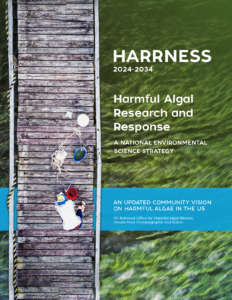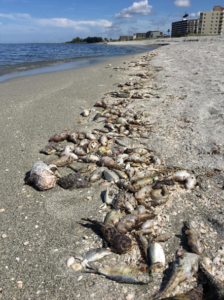U.S. National Office for Harmful Algal Blooms at the Woods Hole Oceanographic Institution Releases National Science Strategy for Harmful Algal Research and Response
 Cyanobacteria bloom in West Reservoir
(Harwich, MA). (Photo by: Mindy Richlen, ©Woods Hole Oceanographic Institution)
Cyanobacteria bloom in West Reservoir
(Harwich, MA). (Photo by: Mindy Richlen, ©Woods Hole Oceanographic Institution)
July 23, 2024
Updated plan builds on major accomplishments, findings
Woods Hole, Mass. (July 23, 2024) - Harmful and toxic algal blooms (HABs) are a well-established and severe threat to human health, economies, and marine and freshwater ecosystems on all coasts of the United States and its inland waters. Their impacts, intensity, and geographic range have increased over past decades, due to both human-induced and natural changes.
Recognizing the urgency of addressing these challenges, the U.S. National Office for Harmful Algal Blooms (HABs) at the Woods Hole Oceanographic Institution (WHOI) has released a comprehensive national science strategy outlining a decade-long roadmap aimed at enhancing our understanding, monitoring, and management of HABs.

The National Office on Harmful Algal Blooms has released a comprehensive national science strategy outlining a decade-long roadmap aimed at enhancing our understanding and management of HABs. (Graphic by: Eric Taylor/©Woods Hole Oceanographic Institution)
“HARRNESS 2024–2034: Harmful Algal Research and Response, A National Environmental Science Strategy” defines the magnitude, scope, and diversity of the HAB problem in United States’ marine, brackish and freshwaters; addresses knowledge gaps; strengthens coordination among agencies, stakeholders, and partners; advances the development of effective research and management solutions; and builds resilience to address the broad range of HAB impacts to vulnerable communities and ecosystems in the USA.
The science strategy is structured around four main themes: 1) HAB observing systems and modeling, 2) HAB detection and ecological impacts, 3) HAB management, and 4) the human dimensions of HABs, including socioeconomics and education. Each theme covers the current scientific and technological landscape, identifies remaining knowledge gaps, and offers future recommendations to advance research, monitoring, and management of HABs.
The science strategy was created by a 26-member Scientific Steering Committee, with additional input from 35 contributors and reviewers from academia, federal and state agencies, institutions, industry, the non-profit sector, consulting firms, and tribal organizations. The new report replaces the outdated, but successful, initial report, HARRNESS 2005 – 2015.
There have been significant advances made in the last two decades, such as improved understanding of bloom dynamics of large-scale regional HABs including Pseudo-nitzschia on the west coast, Alexandrium on the east coast, Karenia on the west Florida shelf, and Microcystis in Lake Erie. The new science strategy also outlines advances in HAB sensor technology, which facilitate deployment on fixed and mobile platforms for long-term, continuous, remote HAB cell and toxin observations. A section on freshwater HABs and impacts is also covered in the new strategy.

Fish killed by the toxic algae Karenia brevis washed up along Florida’s Venice Beach in August of 2018. (Photo by: R. Currier)
“This science strategy, prepared by a long list of scientists, managers, and stakeholders, provides an updated picture of the magnitude of the HAB issues in U.S waters and offers wide-ranging recommendations on next steps to increase the effectiveness of efforts to minimize HABs impacts on human health, the environment, and our economy,” said Don Anderson, director of the U.S. National Office for Harmful Algal Blooms and a senior scientist in Biology at WHOI.
“I applaud the tremendous effort required to develop this strategy and am pleased NOAA was able to provide funding support for its development" said David Kidwell, director of NOAA’s National Centers for Coastal Ocean Science Competitive Research Program (NCCOS CRP) and the NOAA co-chair of the Interagency Harmful Algal Bloom and Hypoxia Workgroup. "The updated national science and response strategy will inform efforts to advance our nation's ability to prevent or minimize damage to our economies, ecosystems and health caused by harmful algae.”
HARRNESS 2024-2034 is available on the U.S. National HAB Office website: https://hab.whoi.edu/wp-content/uploads/2024/07/HARRNESS-2024-online-1.pdf
For more about the U.S National Office for Harmful Algae Blooms, visit: https://hab.whoi.edu/about/
For more about NOAA’s National Center for Coastal Ocean Science, visit: https://coastalscience.noaa.gov/
###
About Woods Hole Oceanographic Institution
The Woods Hole Oceanographic Institution (WHOI) is a private, non-profit organization on Cape Cod, Massachusetts, dedicated to marine research, engineering, and higher education. Established in 1930, its primary mission is to understand the ocean and its interaction with the Earth as a whole, and to communicate an understanding of the ocean’s role in the changing global environment. WHOI’s pioneering discoveries stem from an ideal combination of science and engineering—one that has made it one of the most trusted and technically advanced leaders in basic and applied ocean research and exploration anywhere. WHOI is known for its multidisciplinary approach, superior ship operations, and unparalleled deep-sea robotics capabilities. We play a leading role in ocean observation and operate the most extensive suite of data-gathering platforms in the world. Top scientists, engineers, and students collaborate on more than 800 concurrent projects worldwide—both above and below the waves—pushing the boundaries of knowledge and possibility. For more information, please visit www.whoi.edu.
